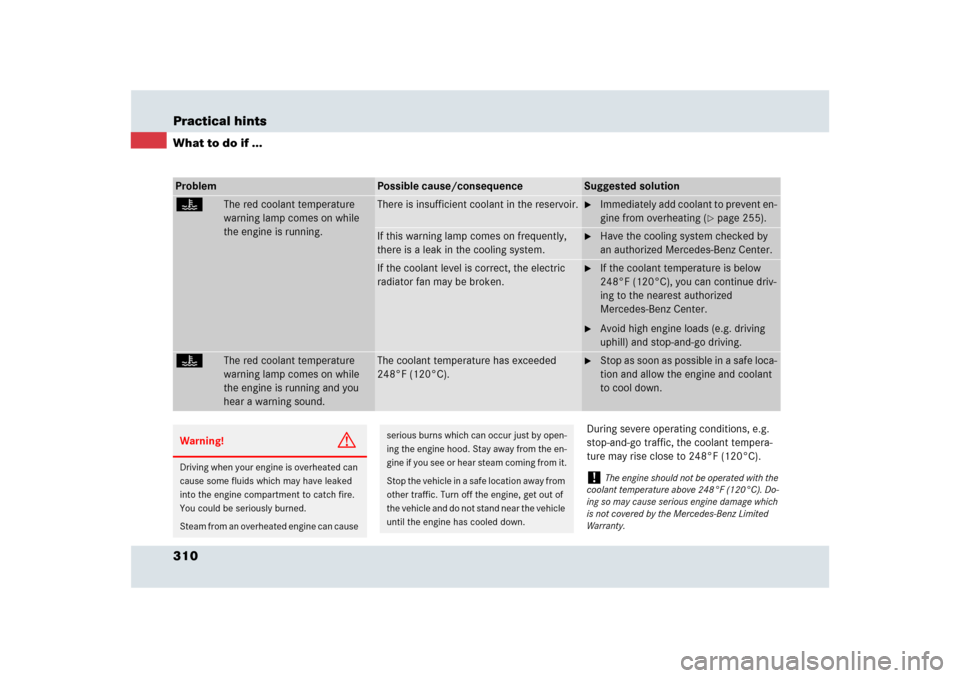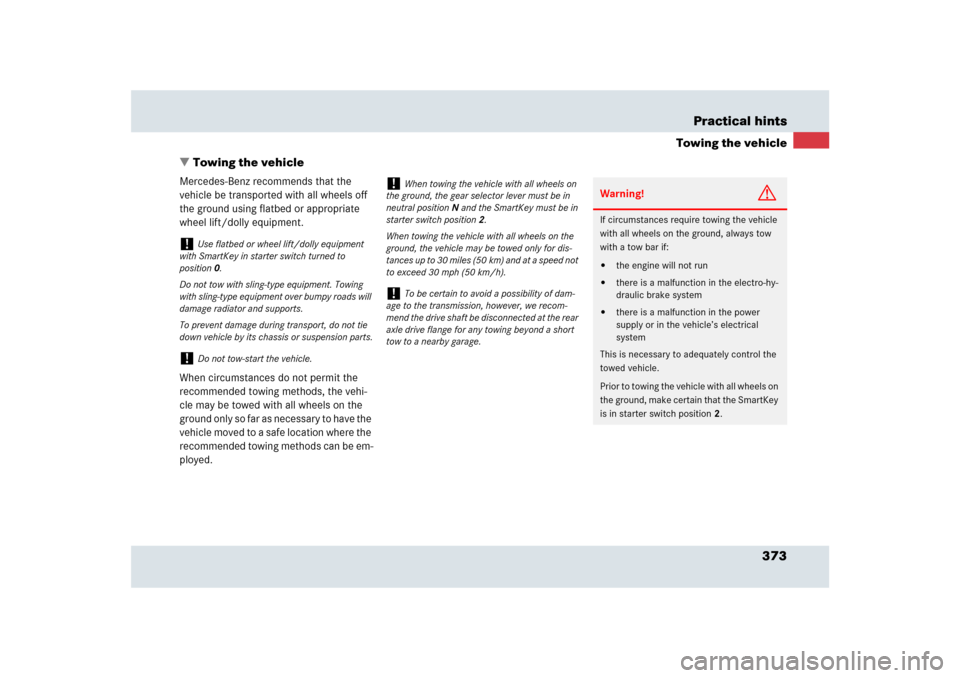Page 250 of 426

250 OperationEngine compartmentHood OpeningWarning!
G
Do not pull the release lever while the
vehicle is in motion. Otherwise the hood
could be forced open by passing air flow.
This could cause the hood to come loose
and injure you and/or others.Warning!
G
The exhaust areas on the engine hood and
between the doors and front wheels get very
hot. Avoid contact with them, otherwise
there is the risk of severe burns.
Warning!
G
If you see flames or smoke coming from the
engine compartment, or if the coolant tem-
perature gauge indicates that the engine is
overheated, do not open the hood. Move
away from the vehicle and do not open the
hood until the engine has cooled. If neces-
sary, call the fire department.Warning!
G
You could be injured when the hood is open
– even when the engine is turned off.
Parts of the engine can become very hot. To
prevent burns, let the engine cool off com-
pletely before touching any components on
the vehicle. Comply with all relevant safety
precautions.
Warning!
G
To help prevent personal injury, stay clear of
moving parts when the hood is open and the
engine is running.
The radiator fan may also start at any time
automatically, even after the SmartKey has
been removed from the starter switch. Stay
clear of fan blades.Warning!
G
The engine is equipped with a transistorized
ignition system. Because of the high voltage
it is dangerous to touch any components
(ignition coils, spark plug sockets, diagnos-
tic socket) of the ignition system�
with the engine running
�
while starting the engine
�
if ignition is “on” and the engine is
turned manually
Page 310 of 426

310 Practical hintsWhat to do if ...
During severe operating conditions, e.g.
stop-and-go traffic, the coolant tempera-
ture may rise close to 248°F (120°C).
Problem
Possible cause/consequence
Suggested solution
D
The red coolant temperature
warning lamp comes on while
the engine is running.
There is insufficient coolant in the reservoir.
�
Immediately add coolant to prevent en-
gine from overheating (
�page 255).
If this warning lamp comes on frequently,
there is a leak in the cooling system.
�
Have the cooling system checked by
an authorized Mercedes-Benz Center.
If the coolant level is correct, the electric
radiator fan may be broken.
�
If the coolant temperature is below
248°F (120°C), you can continue driv-
ing to the nearest authorized
Mercedes-Benz Center.
�
Avoid high engine loads (e.g. driving
uphill) and stop-and-go driving.
D
The red coolant temperature
warning lamp comes on while
the engine is running and you
hear a warning sound.
The coolant temperature has exceeded
248°F (120°C).
�
Stop as soon as possible in a safe loca-
tion and allow the engine and coolant
to cool down.
Warning!
G
Driving when your engine is overheated can
cause some fluids which may have leaked
into the engine compartment to catch fire.
You could be seriously burned.
Steam from an overheated engine can cause
serious burns which can occur just by open-
ing the engine hood. Stay away from the en-
gine if you see or hear steam coming from it.
Stop the vehicle in a safe location away from
other traffic. Turn off the engine, get out of
the vehicle and do not stand near the vehicle
until the engine has cooled down.
!
The engine should not be operated with the
coolant temperature above 248°F (120°C). Do-
ing so may cause serious engine damage which
is not covered by the Mercedes-Benz Limited
Warranty.
Page 373 of 426

373 Practical hints
Towing the vehicle
�Towing the vehicle
Mercedes-Benz recommends that the
vehicle be transported with all wheels off
the ground using flatbed or appropriate
wheel lift/dolly equipment.
When circumstances do not permit the
recommended towing methods, the vehi-
cle may be towed with all wheels on the
ground only so far as necessary to have the
vehicle moved to a safe location where the
recommended towing methods can be em-
ployed.!
Use flatbed or wheel lift/dolly equipment
with SmartKey in starter switch turned to
position0.
Do not tow with sling-type equipment. Towing
with sling-type equipment over bumpy roads will
damage radiator and supports.
To prevent damage during transport, do not tie
down vehicle by its chassis or suspension parts.
!
Do not tow-start the vehicle.
!
When towing the vehicle with all wheels on
the ground, the gear selector lever must be in
neutral positionN and the SmartKey must be in
starter switch position2.
When towing the vehicle with all wheels on the
ground, the vehicle may be towed only for dis-
tances up to 30 miles (50 km) and at a speed not
to exceed 30 mph (50 km/h).
!
To be certain to avoid a possibility of dam-
age to the transmission, however, we recom-
mend the drive shaft be disconnected at the rear
axle drive flange for any towing beyond a short
tow to a nearby garage.
Warning!
G
If circumstances require towing the vehicle
with all wheels on the ground, always tow
with a tow bar if:�
the engine will not run
�
there is a malfunction in the electro-hy-
draulic brake system
�
there is a malfunction in the power
supply or in the vehicle’s electrical
system
This is necessary to adequately control the
towed vehicle.
Prior to towing the vehicle with all wheels on
the ground, make certain that the SmartKey
is in starter switch position2.